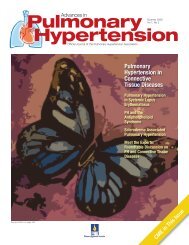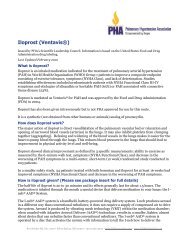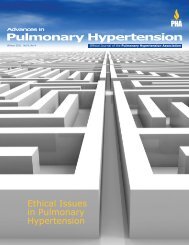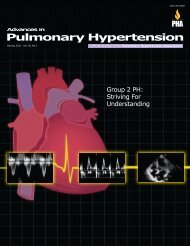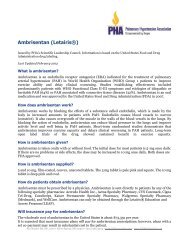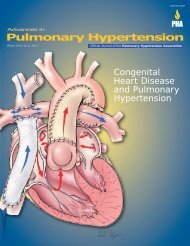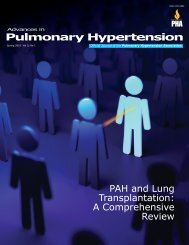Vol 7, No 3 - PHA Online University
Vol 7, No 3 - PHA Online University
Vol 7, No 3 - PHA Online University
Create successful ePaper yourself
Turn your PDF publications into a flip-book with our unique Google optimized e-Paper software.
Conclusion<br />
Although it is not clear how closely any of the neointimal animal<br />
models mimic the multifactorial pathobiology of human PAH, it is<br />
probable that they will provide insights into pathological cellular<br />
and molecular signaling pathways and potentially effective therapies<br />
that would not be revealed or rigorously tested in the classic<br />
chronically hypoxic and monocrotaline-injected models.<br />
Another point is that while prevention studies may provide useful<br />
information, the more clinically relevant experiment is to determine<br />
if the treatment reverses the neointimal arteriopathy and hypertension<br />
once they are well established. Finally, it needs to be<br />
noted that even if a novel drug or therapeutic strategy is found to<br />
effectively reverse PAH, and/or prevent right ventricular failure<br />
and death, in one or more of the animal models, that doesn’t necessarily<br />
mean it will work in the human forms of PAH. The cellular<br />
and molecular pathogenesis of obstructive vascular lesions,<br />
and the mechanisms of right ventricular dysfunction, that develop<br />
over a few weeks in the animal models may not duplicate that<br />
which occurs over months or years in human PAH. Careful and<br />
rigorous clinical trials will be required to establish the safety and<br />
efficacy of any new therapy in patients. 69<br />
References<br />
1. Simonneau G, Galiè N, Rubin LJ, et al. Clinical classification of pulmonary<br />
hypertension. J Am Coll Cardiol. 2004;43:5S-12S.<br />
2. Chin KM, Kim NH, Rubin LJ. The right ventricle in pulmonary hypertension.<br />
Coron Artery Dis. 2005;16:13-18.<br />
3. Hemnes AR, Champion HC. Right heart function and haemodynamics in<br />
pulmonary hypertension. Int J Clin Pract Suppl. 2008:11-19.<br />
4. Voelkel NF, Quaife RA, Leinwand LA, et al. Right ventricular function and<br />
failure: Report of a national heart, lung, and blood institute working group on<br />
cellular and molecular mechanisms of right heart failure. Circulation.<br />
2006;114:1883-1891.<br />
5. Chan SY, Loscalzo J. Pathogenic mechanisms of pulmonary arterial hypertension.<br />
J Mol Cell Cardiol. 2008;44:14-30.<br />
6. Humbert M, Morrell NW, Archer SL, et al. Cellular and molecular pathobiology<br />
of pulmonary arterial hypertension. J Am Coll Cardiol. 2004;43:13S-24S.<br />
7. Rabinovitch M. Pathobiology of pulmonary hypertension. Annu Rev Pathol.<br />
2007;2:369-399.<br />
8. Widlitz A, Barst RJ. Pulmonary arterial hypertension in children. Eur Respir<br />
J. 2003;21:155-176.<br />
9. Mooi WJ, Grungerg K. Histopatholgy of pulmonary hypertensive diseases.<br />
Current Diag Pathol. 2006;12:429-440.<br />
10. Pietra GG, Capron F, Stewart S, et al. Pathologic assessment of vasculopathies<br />
in pulmonary hypertension. J Am Coll Cardiol. 2004;43:25S-32S.<br />
11. Tuder RM, Marecki JC, Richter A, et al. Pathology of pulmonary hypertension.<br />
Clin Chest Med. 2007;28:23-42, vii.<br />
12. Wagenvoort CA. Open lung biopsies in congenital heart disease for evaluation<br />
of pulmonary vascular disease: predictive value with regard to corrective<br />
operability. Histopathology. 1985;9:417-436.<br />
13. Yi ES, Kim H, Ahn H, et al. Distribution of obstructive intimal lesions and<br />
their cellular phenotypes in chronic pulmonary hypertension. A morphometric<br />
and immunohistochemical study. Am J Respir Crit Care Med. 2000;162:<br />
1577-1586.<br />
14. Palevsky HI, Schloo BL, Pietra GG, et al. Primary pulmonary hypertension.<br />
Vascular structure, morphometry, and responsiveness to vasodilator agents.<br />
Circulation. 1989;80:1207-1221.<br />
15. Sitbon O, Humbert M, Jais X, et al. Long-term response to calcium channel<br />
blockers in idiopathic pulmonary arterial hypertension. Circulation.<br />
2005;111:3105-3111.<br />
16. Levy M, Maurey C, Celermajer DS, et al. Impaired apoptosis of pulmonary<br />
endothelial cells is associated with intimal proliferation and irreversibility of<br />
pulmonary hypertension in congenital heart disease. J Am Coll Cardiol.<br />
2007;49:803-810.<br />
17. Rich S. The current treatment of pulmonary arterial hypertension: time to<br />
redefine success. Chest. 2006;130:1198-1202.<br />
18. Macchia A, Marchioli R, Marfisi R, et al. A meta-analysis of trials of pulmonary<br />
hypertension: a clinical condition looking for drugs and research<br />
methodology. Am Heart J. 2007;153:1037-1047.<br />
19. Rich S. The value of approved therapies for pulmonary arterial hypertension.<br />
Am Heart J. 2007;153:889-890.<br />
20. Campian ME, Hardziyenka M, Michel MC, et al. How valid are animal<br />
models to evaluate treatments for pulmonary hypertension? Naunyn Schmiedebergs<br />
Arch Pharmacol. 2006;373:391-400.<br />
21. Jeffery TK, Wanstall JC. Pulmonary vascular remodeling: A target for therapeutic<br />
intervention in pulmonary hypertension. Pharmacol Ther. 2001;92:1-<br />
20.<br />
22. Marsboom GR, Janssens SP. Models for pulmonary hypertension. Drug<br />
Discovery Today: Disease Models. 2004;1:289-296.<br />
23. Michelakis ED, Wilkins MR, Rabinovitch M. Emerging concepts and translational<br />
priorities in pulmonary arterial hypertension. Circulation. 2008;118:<br />
1486-1495.<br />
24. Bauer NR, Moore TM, McMurtry IF. Rodent models of pah: Are we there<br />
yet? Am J Physiol Lung Cell Mol Physiol. 2007;293:L580-582.<br />
25. Heath D. The rat is a poor animal model for the study of human pulmonary<br />
hypertension. Cardioscience. 1992;3:1-6.<br />
26. Voelkel NF, Tuder RM. Hypoxia-induced pulmonary vascular remodeling:<br />
A model for what human disease? J Clin Invest. 2000;106:733-738.<br />
27. White RJ. Pulmonary arterial hypertension: Building a better mouse trap<br />
for 2010. Drug Discovery Today: Therapeutic Strategies. 2004;1:351-359.<br />
28. Zaiman A, Fijalkowska I, Hassoun PM, et al. One hundred years of research<br />
in the pathogenesis of pulmonary hypertension. Am J Respir Cell Mol<br />
Biol. 2005;33:425-431.<br />
29. McMurtry IF, Gebb SA, Jones PL. Pulmonary vascular remodeling. In: Laurent<br />
GJ, Shapiro SD,eds. Encyclopedia of Respiratory Medicine. New York:<br />
Academic Press; 2006:. 591-599.<br />
30. Oka M, Fagan KA, Jones PL, et al. Therapeutic potential of rhoa/rho kinase<br />
inhibitors in pulmonary hypertension. Br J Pharmacol. 2008;155:444-<br />
454.<br />
31. Tenmark KR, McMurtry IF. Vascular remodeling versus vasoconstriction<br />
in chronic hypoxic pulmonary hypertension: a time for reappraisal? Circ Res.<br />
2005;97:95-98.<br />
32. McLoughlin P, McMurtry I. Counterpoint: chronic hypoxia-induced pulmonary<br />
hypertension does not lead to loss of pulmonary vasculature. J Appl<br />
Physiol. 2007;103:1451-1453; discussion 1453-1454.<br />
33. Rabinovitch M, Chesler N, Molthen RC. Point:Counterpoint: chronic hypoxia-induced<br />
pulmonary hypertension does/does not lead to loss of pulmonary<br />
vasculature. J Appl Physiol. 2007;103:1449-1451.<br />
34. Dumitrascu R, Koebrich S, Dony E, et al. Characterization of a murine<br />
model of monocrotaline pyrrole-induced acute lung injury. BMC Pulm Med.<br />
2008;8:25.<br />
35. Hoshikawa Y, Nana-Sinkam P, Moore MD, et al. Hypoxia induces different<br />
genes in the lungs of rats compared with mice. Physiol Genomics. 2003;<br />
12:209-219.<br />
36. Durmowicz AG, Orton EC, Stenmark KR. Progressive loss of vasodilator responsive<br />
component of pulmonary hypertension in neonatal calves exposed<br />
to 4570 m. Am J Physiol. 1993;265:H2175-2183.<br />
37. Jaenke RS, Alexander AF. Fine structural alterations of bovine peripheral<br />
pulmonary arteries in hypoxia-induced hypertension. Am J Pathol. 1973;73:<br />
377-398.<br />
38. Bonnet S, Michelakis ED, Porter CJ, et al. An abnormal mitochondrial-hypoxia<br />
inducible factor-1alpha-kv channel pathway disrupts oxygen sensing and<br />
triggers pulmonary arterial hypertension in fawn hooded rats: Similarities to<br />
human pulmonary arterial hypertension. Circulation. 2006;113:2630-2641.<br />
39. Nagaoka T, Gebb SA, Karoor V, et al. Involvement of rhoa/rho kinase signaling<br />
in pulmonary hypertension of the fawn-hooded rat. J Appl Physiol.<br />
2006;100:996-1002.<br />
40. Sato K, Webb S, Tucker A, et al. Factors influencing the idiopathic development<br />
of pulmonary hypertension in the fawn hooded rat. Am Rev Respir<br />
Dis. 1992;145:793-797.<br />
41. Achcar RO, Demura Y, Rai PR, et al. Loss of caveolin and heme oxygenase<br />
expression in severe pulmonary hypertension. Chest. 2006;129:696-705.<br />
42. Faul JL, Nishimura T, Berry GJ, et al. Triptolide attenuates pulmonary arterial<br />
hypertension and neointimal formation in rats. Am J Respir Crit Care<br />
Med. 2000;162:2252-2258.<br />
43. Greenway S, van Suylen RJ, Du Marchie Sarvaas G, et al. S100a4/mts1<br />
produces murine pulmonary artery changes resembling plexogenic arteriopathy<br />
and is increased in human plexogenic arteriopathy. Am J Pathol.<br />
2004;164:253-262.<br />
44. Homma N, Nagaoka T, Karoor V, et al. Involvement of rhoa/rho kinase signaling<br />
in protection against monocrotaline-induced pulmonary hypertension in<br />
pneumonectomized rats by dehydroepiandrosterone. Am J Physiol Lung Cell<br />
Mol Physiol. 2008;295:L71-78.<br />
348 Advances in Pulmonary Hypertension



